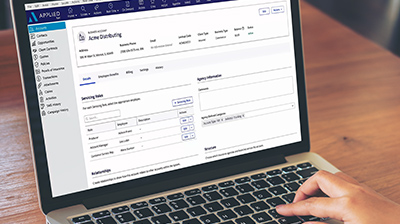In today’s fast-paced and digital world, it’s critical for agencies to evolve business operations and adopt technology to meet consumer expectations. Nevertheless, with adopting the latest innovation comes change, and change can sometimes be difficult.
We realize that migrating to a new system may seem overwhelming. But at Applied, we are here to make the complex simple for you. We’ve already helped numerous agencies just like yours migrate to a new agency management system to realize the benefits of having a single, integrated system.
To give you an idea of what to expect during the implementation process, we asked Abby Larson, Sr. Manager of Implementation Services at Applied Systems, the most frequently asked questions around migrating to a new system in this two part series.
Applied Communications: What’s one of the most beneficial things a client can do today to start preparing for an implementation?
Abby Larson: Planning is such an important first step in software implementation and is key to having a successful adoption. To start, it’s important to understand your why. Ask yourself, “Why am I making this investment and change?;” “What's in it for me, my organization and my staff?;” “What are my top goals and requirements for this transition?”
Knowing the answers to these questions and understanding your why will help you tremendously as you begin the planning process. Successful software adoption starts with an implementation plan tailored to specific goals and needs. We’ve proven this after leading thousands of organizations through the implementation process at Applied. When you start with your why – your specific goals and needs – you know what features to implement and when, you can keep your staff focused on the right things, and you can communicate to your staff easily regarding why you made this decision and what's in it for them to gain buy-in and engagement.
After you identify your why, think about who you will have lead the project and how the rest of your staff will be involved. As soon as the project starts, you’ll want to be able to choose the right team members to be involved, clearly communicate the goals to them, and set appropriate expectations for your entire staff.
Applied: How can business owners support their employees through this change?
Abby: It's important to understand and recognize that this will be a significant change for your organization and staff. How you lead your staff through this change is such an important part of the overall implementation project and your success. We encourage you to implement a change management strategy to help ease the transition. Change management considers the human element or gray area within the implementation process that appears very black and white.
The most effective change management strategies include:
- Clearly defining your why (as discussed above): Why are you making this investment and this change? What's in it for you as a business leader, for your organization, for your staff? What are your top goals/requirements for activation?
- Communicating with your staff regularly and appropriately: Change in the workplace, if not managed effectively, can create fear of the unknown causing resistance and a negative experience for all involved. It’s important for the entire staff to share in your excitement of the new capabilities and increased efficiencies your new technology will bring.
- Identifying your champions and challengers: You will want to be intentional about how you involve your team to get the desired outcome. Seek out who your champions are and use them to your advantage. That could mean pairing up champions with challengers. It could mean involving a challenger in some of the decision-making so they have a voice and will support the decisions made. This will be different from employee to employee and organization to organization.
- Making it fun: Maintaining a positive environment through training, adoption and continued learning post-activation will help ensure that same positivity translates to your customers' experience. This will be a memorable time at your organization, and can be a great teambuilding opportunity that will make you stronger as a team and an organization.
Effective planning and executing your change management strategy will help manage the emotions and variables both during and after the implementation process and help employees understand, commit to, accept, and embrace this change within the organization.
Applied: What can an organization do to achieve a successful implementation?
Abby: Here are some of our team’s top tips for a successful software implementation:
- Gain executive buy-in: Your leadership team members, including your top executives even if they’re not involved in the project activity day-to-day, must be on board and supportive of the core implementation team, empowering them to effectively lead and make decisions, and be empathetic to the staff.
- Identify your core team: Your core implementation team is key. Choose a diverse group of individuals who have different strengths and can work as a team. Individuals will need to be detail-oriented but can also look at the bigger picture.
- Set your priorities: There are many exciting features Applied offers with its software solutions. Features and functionality that will make it easier for you to do business with your partners and for your insureds to do business with you, create a better working environment for your staff, and set you apart in the market. However, realize that not everything can be done prior to activation. Prioritize what is important for your organization so you can understand what features you are going to implement and when.
- Have a solid training plan in place: Your goal will be to prepare your staff to be effective upon activation of your new software solution. This means your staff should be able to perform their regular daily tasks at activation. You and your staff will learn the Applied Digital Solution in three layers: completing Applied University courses to provide foundational knowledge, practicing workflows to become familiar before activation and private engagements. Put a plan in place for your team to execute.
- Make staff accountable: Hold your staff accountable to complete the training plan you outline. This could be formal management accountability/performance reviews or it could be peer-to-peer accountability. We’ve seen organizations team employees up and create healthy competitions so that the team members are holding each other accountable to not let the team down.
- Communication, communication, communication: Communicate regularly with your staff. What’s it in for them? What do you need them to do? And by all means, keep all of your communication positive.
- Maintain focus: Keep your focus on your top priorities. As Stephen Covey once said, “The main thing is to keep the main thing the main thing.”
Applied: How much time should a client allocate to the project weekly?
Abby: Our clients estimate 10 hours per week for core team members on average, though there are many variables that can impact this including, expectations, duration of the project and team size.
The time investment for the rest of the staff (end users) would be less than that of the core team on average and would depend on role. All end users will need to take training courses in Applied University and also work in a sample or demo database for practice. The current estimate we have for Applied University is about 20-25 hours of training and practice exercises. This is for a commercial lines representative, which tends to have more training than others (PL, Benefits) due to the number of Applied University courses.
Applied: What are the best practices for training a team?
Abby: Your core team members should begin training via Applied University at the start of the implementation project so they are prepared to make educated configuration decisions and to navigate Applied Epic® effectively during data conversion review (if applicable). The rest of the staff will begin their Applied University training and practicing workflows closer to activation.
Be sure to check out Insider Tips: Switching Agency Management Systems – Pt. 2 for more insights.
Abby Larson, Sr. Manager of Implementation Services, is a leader on Applied’s Primary Implementation Team, a team committed to successfully leading agencies and brokers through implementation of new software solutions. Abby joined the Applied team in August 2010 as an Implementation Lead starting first with managing Applied TAM to Applied TAMCloud and new Applied TAM system implementations before transitioning to Applied Epic implementation projects in 2012 and then moving into Management in 2014. Abby was recognized by her peers in 2014 and received the Circle of Excellence award, Applied’s highest employee honor. Prior to joining Applied, Abby was the Director of Operations for the Chicagoland branch of Dale Carnegie Training, also holding Sales and Marketing roles in her six years there. She holds a bachelor’s degree from University of Illinois at Urbana-Champaign.
 By:
By: 

